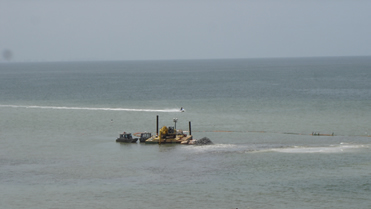Update
On February 3, 2013, a multi-agency discussion was held on the topic of Nearshore Berms in the State of Florida and the state of the science and understanding of the practice of placing sediment within the nearshore. Participants included representatives from the U.S. Army Engineer District, Jacksonville (CESAJ), the Florida Department of Environmental Protection, the U.S. Fish and Wildlife Service, the Florida Fish and Wildlife Conservation Commission, National Oceanic and Atmospheric Administration (NOAA), and the Florida Shore and Beach Association. This was the first discussion held by CESAJ in a series with regards to nearshore placement. Below is an agenda and three presentations of the topics discussed.
For more information, contact the below POCs for the respective organization.
US Army Engineer District, Jacksonville (CESAJ)
US Army Engineer Research and Development Center (ERDC)
 Dredging of Corps navigation projects results in hundreds of millions of cubic yards of sediment displaced each year. Many options for disposal or placement of the material exist, including Beneficial Use through creation of islands or wetlands, upland and offshore placement, direct beach placement, and nearshore placement. In recent years the Corps’ project-centric focus has changed toward a more systematic approach that considers the sediment a valuable resource as part of the regional littoral system. The Corps’ National Regional Sediment Management (RSM) Program actively supports research on, and support for, modifying outdated project guidelines with new systematic approaches toward managing sediment as a resource. Ultimately, the goal of the RSM Program is to use these new approaches to move successfully sediments to desirable locations that benefit the region.
Dredging of Corps navigation projects results in hundreds of millions of cubic yards of sediment displaced each year. Many options for disposal or placement of the material exist, including Beneficial Use through creation of islands or wetlands, upland and offshore placement, direct beach placement, and nearshore placement. In recent years the Corps’ project-centric focus has changed toward a more systematic approach that considers the sediment a valuable resource as part of the regional littoral system. The Corps’ National Regional Sediment Management (RSM) Program actively supports research on, and support for, modifying outdated project guidelines with new systematic approaches toward managing sediment as a resource. Ultimately, the goal of the RSM Program is to use these new approaches to move successfully sediments to desirable locations that benefit the region.
Nearshore berm placement is one RSM approach in the coastal zone that has the potential to provide an immediate benefit to the littoral zone and Corps-related projects along the coast. As sediment is removed out of a littoral system through dredging, placement in the nearshore reintroduces the sediments to an adjacent littoral region which preserves valuable sediment resources that would have otherwise been lost to the nearshore system. The physical benefits of this practice to the adjacent beaches include wave attenuation and adding material to the nearshore beach profile which may be reworked by processes to enhance the beach system. When in place, nearshore berms pose minimal impact to the environment if placed in what is typically an active littoral zone. In general, material dredged from coastal navigation channels often performs optimally when placed in adjacent littoral cells with compatible materials. Questions as to whether fines migrate onshore or disturb subaqueous habitat during the placement process or degrade water quality through suspension for some time following the placement must be addressed on a site specific basis. Improved guidelines must address the issues of calculating the benefits and the potential detriments of nearshore placement.